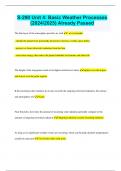Samenvatting
Applied Financial Econometrics - Summary of the Lectures
Important: this summary follows the order of the lectures in this specific course, not the chapters of the book. If you want to know what the lecturer discussed during these lectures, this is your perfect summary!
[Meer zien]













